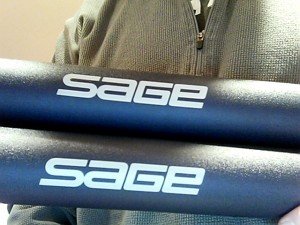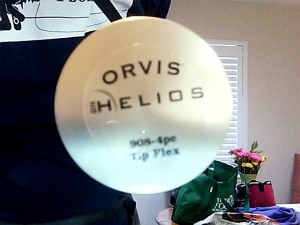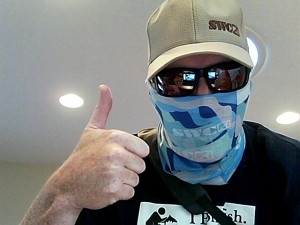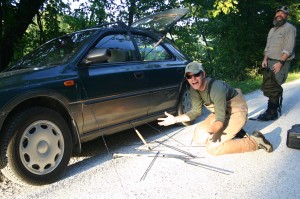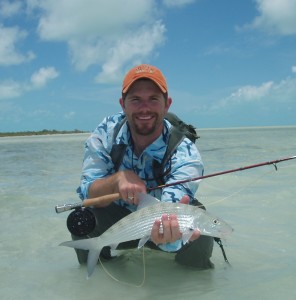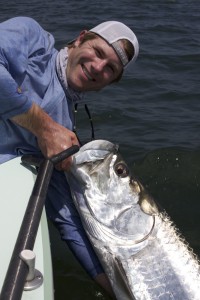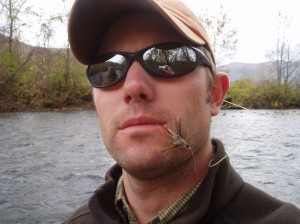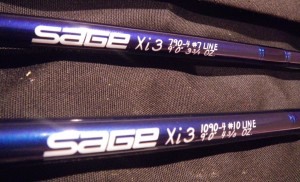The fourth day of the trip and the third day in Belize saw us heading out with a guide for the first time. El Pescador had a stable of highly respected guides and this day we would head out with Katchu. We met him on the dock at 7 and got on the panga, heading south to head through the passage in San Padro. From there, we’d head north to the tarpon hunting grounds of Savannah Cay. That is what we thought was happening anyway.
As we made it through the mangrove and shack lined cut to the bay side of Ambergris we surprisingly went south and in a few minutes the guide stopped the boat and, frantically, said “Where’s the permit rod?!” We weren’t rigged for permit, we thought we were headed to fish tarpon. Katchu was a big agitated, but we finally got rigged up, I was up first and I made my first cast to a school of marauding permit. They didn’t eat. We probably spent an hour chasing nervous water, but the fish were just not in range most of the time. We called time on Permit and headed North for tarpon.
The Savannah Cay flat is 16 miles long, all water 3-6 feet deep. The bottom is a mixture of white mud and turtle grass/aquatic plants. When we got there we saw 4 other boats. On a busy day, Katchu told us, there can be FORTY boats there. I really can’t imagine that place with 40 boats… it wouldn’t be good/fun I have a feeling.

Shane... waiting.
We had cloud cover when we got there, but the skies to the west were mostly clear. It was going to be a good weather day. I was up on the bow first and I surprise myself by spotting the first two tarpon. They were a bit too close to the boat. Casts were made. Fish were not eating.
Katchu spotted nervous water heading toward the boat. A school of tarpon was headed for us. I made the cast. I stripped. The fish ate. I set the hook hard. I raised the rod to clear the line. Ummm… turns out you don’t clear the line like you are fishing bonefish. The fly popped out. I was 0/1 and had botched the job on my first tarpon.
Shane was up next and the first fish to the boat would be coming soon. It wasn’t a tarpon, however. Nervous water, moving fast, relieved a school of jacks. Shane cast in the middle of the school and all hell broke loose. As he stripped his fly fast one fish left the school to chase the fly. Water was sheeting it over it’s head as it chased down that fly. It ate and it started its run. A Jack is a bull dog. It doesn’t jump, it doesn’t head shake. It just picks a direction and goes there. A few minutes later and Shane landed a Jack that ran about 15 pounds or so.
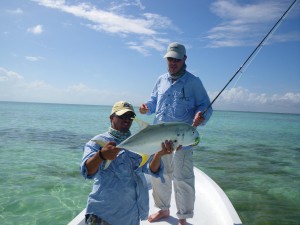
A nice jack, first fish of the day
I was up. Tarpon fishing is long stretches of inactivity, punctuated by frantic moments. I stood there for a while, maybe an hour, without a fish to cast to. Then… nervous water, a school of tarpon coming towards us. I made the cast, but my strip was too fast and the fish turned away. Shane was up again.
Soon, we saw a single tarpon. Shane made the cast and even I saw the fish turn, see the fly and just go up to it and open its massive mouth and eat the fly. Shane did everything right and after a few good jumps the fish was in.
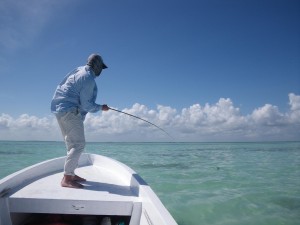
Fish On!
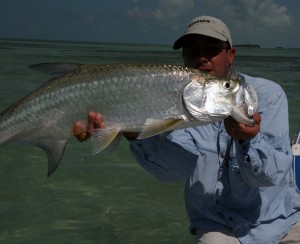
That's what we were after
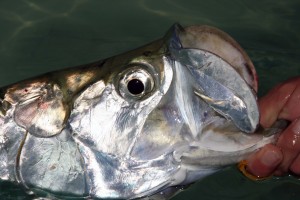
A cool animal
I was back on deck. We went to the north side of Savannah Cay, but the wind had churned up the water and it was too hard to see the fish. We moved back to where we had started. Most of the other boats had left at this point and there was just one other boat, also from El Pescador, left on the 16 mile long flat.
As I was on the deck, Katchu again spotted nervous water. We weren’t sure if they were jacks or tarpon, but I was going to cast at them regardless. “As long as you can, get as much line as you can out and cast as far as you can!” Katchu barked. I stripped line of and started pounding false casts out to get all that line out. Just as I was about to lay down the cast I saw the fish. They were Jacks and they weren’t 80 feet away, they were 20 feet away. I tried to drop the cast short and it all didn’t go well. I had way too much slack out and couldn’t get tight to the fly. The fish moved on. There were some tense words between Shane and Katchu about the difference between “As much line as you can” and 20 feet. I think Katchu even said at one point “I can’t believe you fucked up that cast.” Katchu just wanted it all to happend and he wanted it so bad that if you screw something up, he’s prone to tell you about it.
While we were still having our conversations about exactly how it all went wrong the school of jacks reappeared. I made the cast and the school went insane. The school of fish balled up in a feeding frenzy. I couldn’t see into the school, as the chaos had churned up the bottom. I just kept stripping, felt weight and set the hook. The jack just took off. I stood up there on the deck watching the line just rip out. The run lasted maybe 60 solid seconds, taking about 200 yards of line out. If ever there was a workout for a reel, this has to be it. The Nautilus NV 10-11 did the job very, very well. The Sage Xi3 10 weight we bent at the cork on this fish. Jacks are just amazingly strong and more fun than is reasonable.
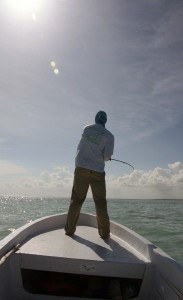
And it is off to the races.

Nautilus... good job.
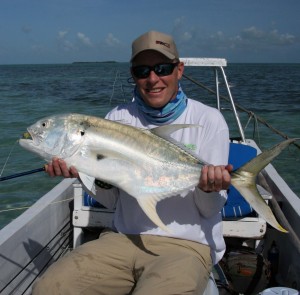
Damn nice fish.
The Jack probably went 25 pounds, making it my largest fish ever.
There were no more tarpon. There were no more jacks. We were done for the day. Even though I didn’t get a tarpon, it still felt like a good day. He had lots of fish to cast to. I had hooked my first tarpon. I had caught my largest fish ever. It had been fun. I had learned a lot.
The next day was going to be about production on our last full day in Belize.














